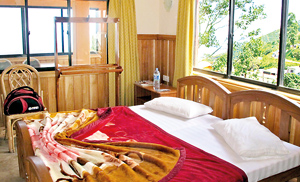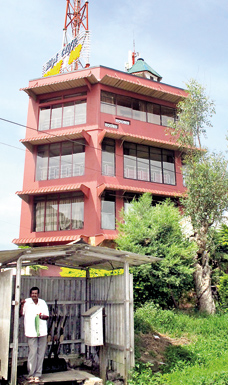Back to those carefree happy days
Twenty years ago I stayed at High Cliffe, by the railway line close to Haputale station. Then it had recently been transformed from a den for backpacking young hippies to a modest guesthouse. Its reputation as a hang out for hippies began with its conversion from a granite-walled bungalow to a warren of rooms packed with bunk beds in the late 1970s. In the low-budget backpacker’s guide Lonely Planet it was described in 1980 as having “Six dorm beds at Rs. seven per person…it’s an old fashioned and easy going place.”

Modern rooms: Cosy comfort with a view
In the 1990s, under new ownership, it was smartened up as the hippies became history and tourists demanded attached bathrooms. The dormitory bunks were thrown out and replaced with twin beds and five rooms were modernised and provided with hot water too. Room rates in 1993 were Rs.350 for a double; breakfast Rs.50.
I have been returning to High Cliffe ever since. One reason is because I am enchanted by Haputale. It’s a small town whose main road seems to soar off into space as it heads southwards. It has a miniature gothic Anglican church with a cemetery of neatly kept graves of dead colonials perched above the bus station, and is close to Adisham, the ponderous 1930s mansion that is a retreat for Benedictine novitiates.
The surrounding hills are dedicated to tea. The mountain lookout where Thomas Lipton — the pioneer promoter of pure Ceylon tea ‘from the tea garden to the tea pot’ — used to survey his plantations, has become a tourist attraction. The incredible view is often covered in mist and the lookout sometimes windswept and chilly. Lipton’s original Dambatenne tea factory, reputed to be the longest in Sri Lanka, is close by.
Staying at High Cliffe is a fine way to experience the old style rural life of this plantation town. Haputale is 1,431m above sea level with a crisp climate, residents who don’t trouble strangers, and odd relics of the past, such as a red-painted George VI letter box outside the town’s brick-built post office.

High Cliffe: Fine way to experience the old style rural life of Haputale town
High Cliffe itself has undergone expansion. There are only three rooms available in the old bungalow now, each clean and meticulously furnished with comfortable beds and up-to-date bathrooms. The old parlour still remains with panes of green, red and blue glass that form a frieze above the windows and with a cosy clutter of old furniture and knickknacks.
A new extension has been added to the granite bungalow, a four storey building painted lurid deep pink. A neon rooftop sign proclaims ‘High Cliffe Resort & Bar’. It is a landmark that dominates the skyline. The place is mainly popular because of its bar on the first floor with a spectacular view of trains trundling through the town.
There are six bedrooms on the floors above the bar and these have been cleverly designed to maximise the breathtaking views where hills and valleys run down to the distant south coast. There is an outside iron staircase to the rooms so guests don’t have to pass through the bar to go to bed.
Each room is reassuringly modern, with walls of half wooden panels, sturdy beds with warm blankets for those cold nights, windows that slide open to let in fresh air (no AC is necessary) and with a desk, power points for laptops, and a flat screen television on one wall. The bathrooms are bright and airy, designed with convenience and expensive fittings; there are hooks where they should be.
On the top floor, there is a private dining alcove with a view of Haputale where meals are served on demand. Breakfasts are also served to guests on the glassed-walled balconies on the third and fourth floors with their staggering, panoramic views of the rolling hillside.
While its prices have increased from 20 years ago (a double room is now Rs 2,500), the informal atmosphere of carefree happy days remains, making High Cliffe a welcoming, unpretentious place for both local and foreign tourists to stay while relishing the simple charm that characterises Haputale.
(High Cliffe Hotel, Station Road, Haputale; 057 2268096)
comments powered by Disqus

